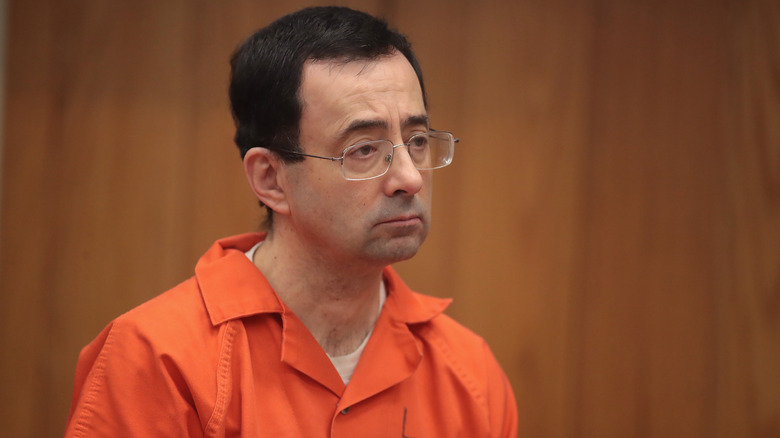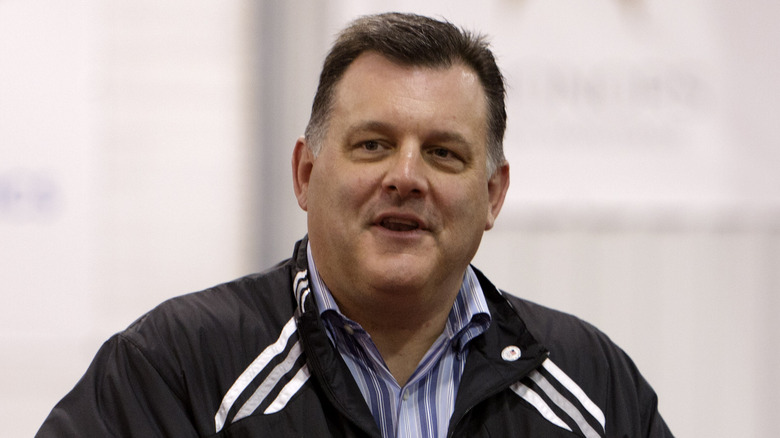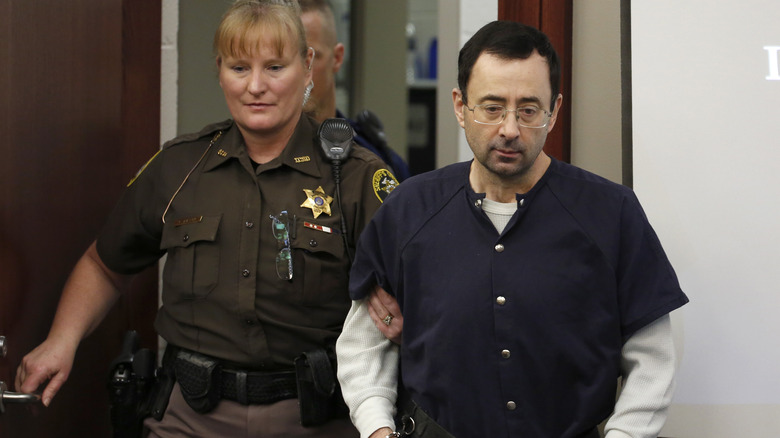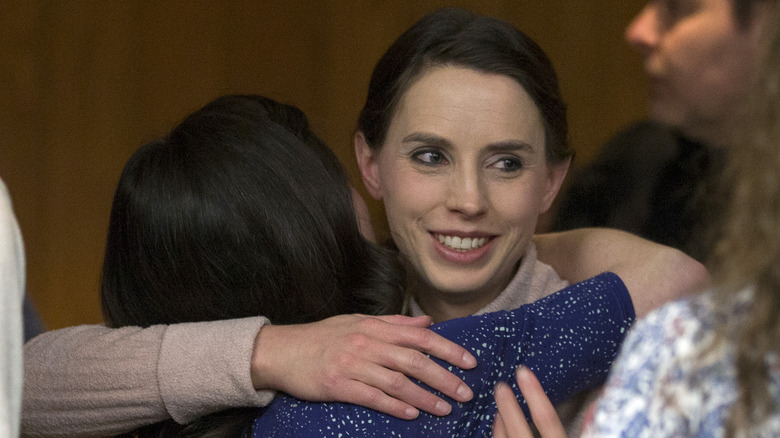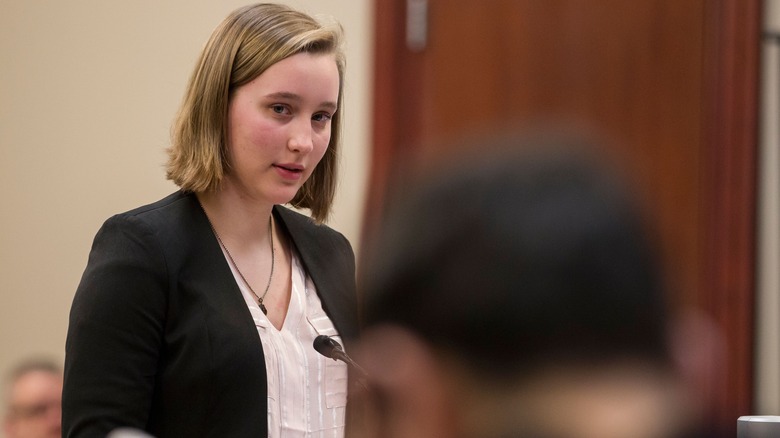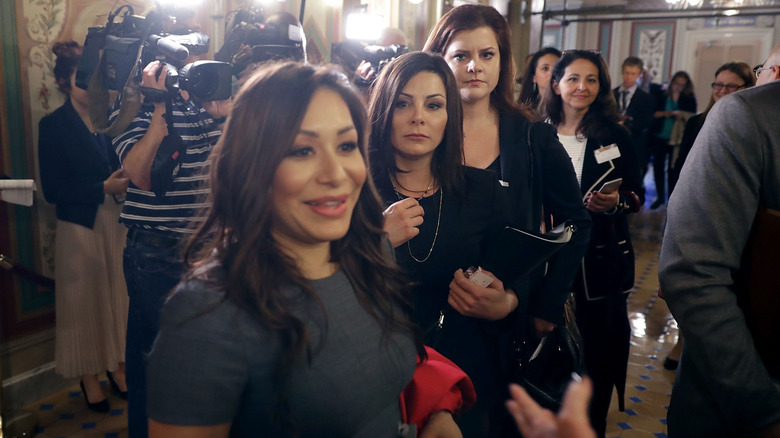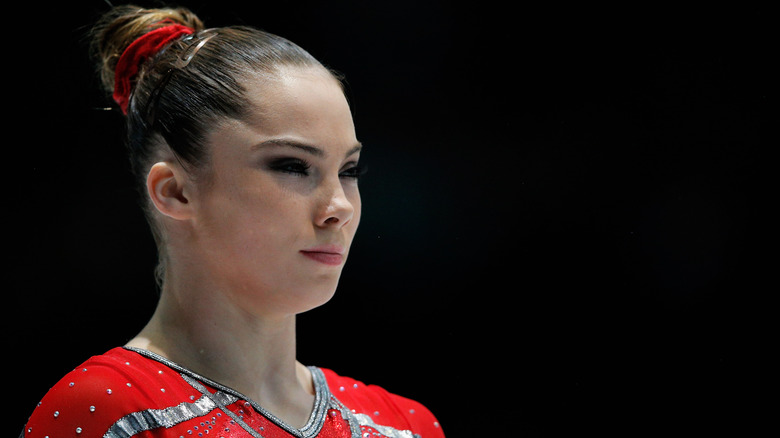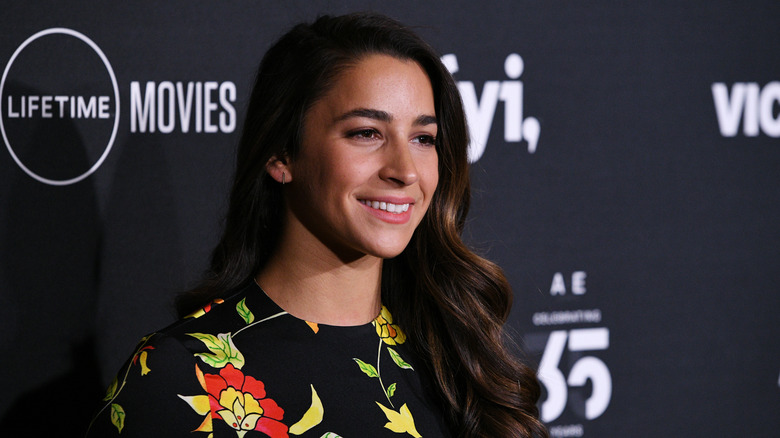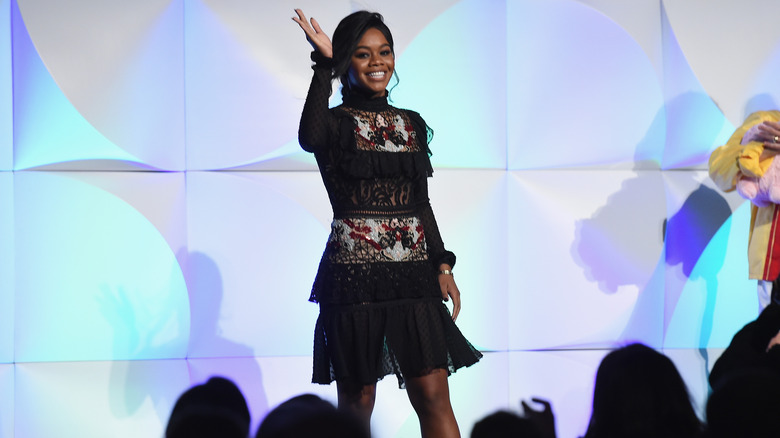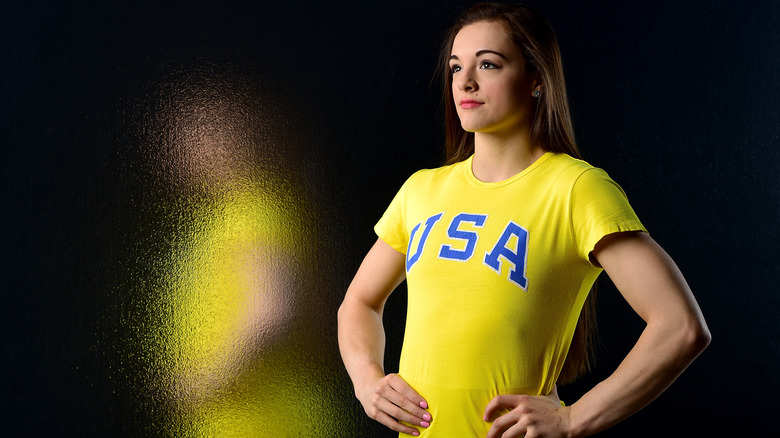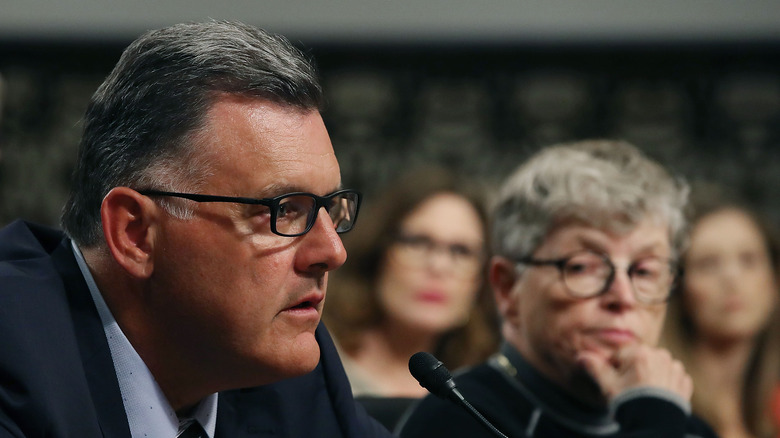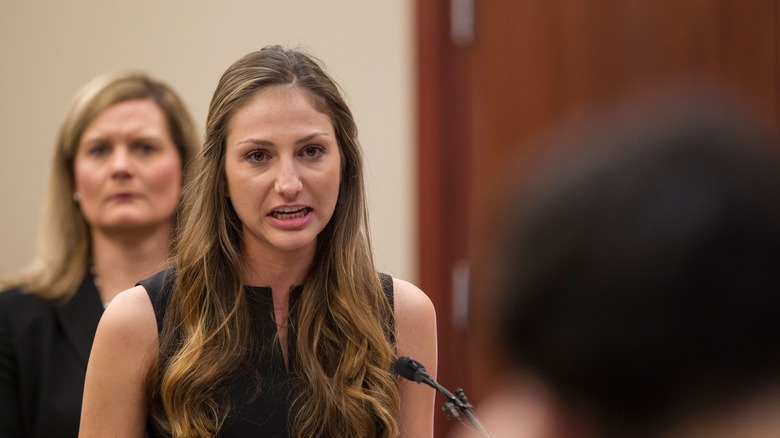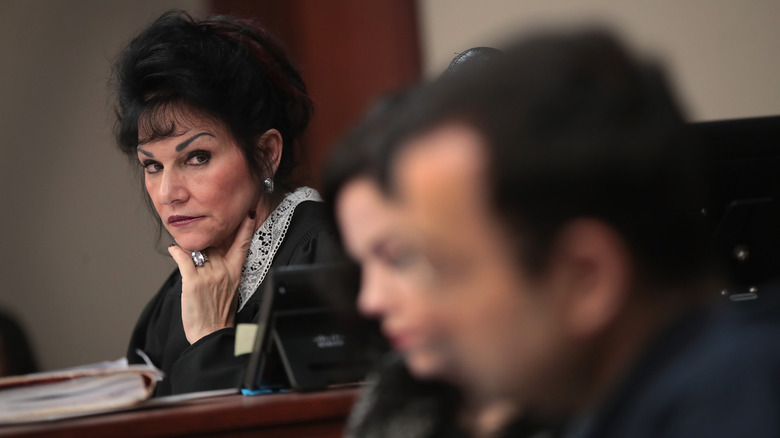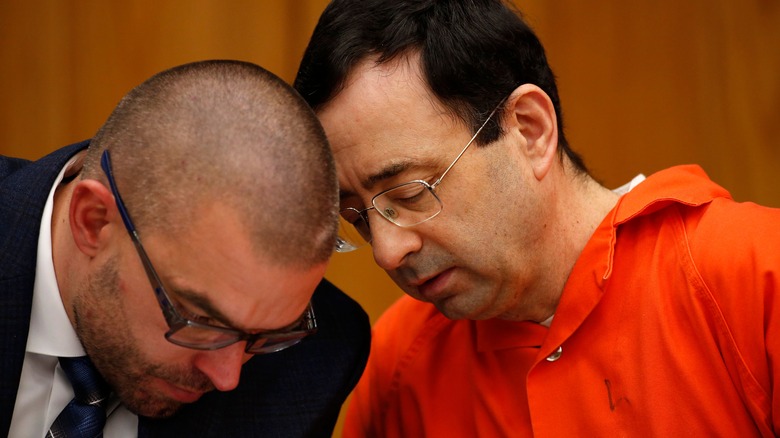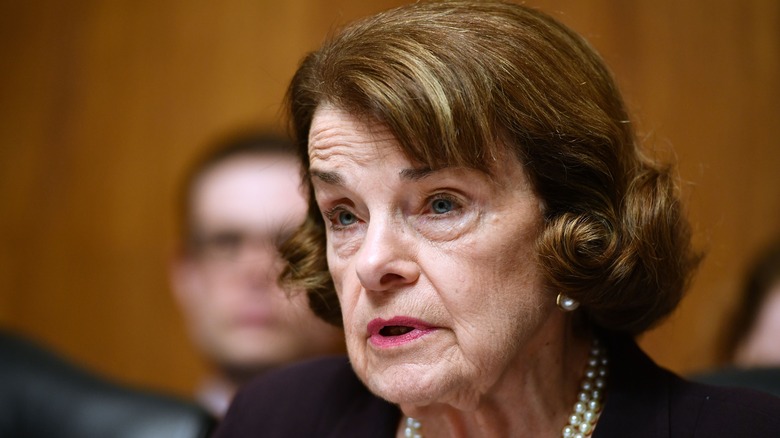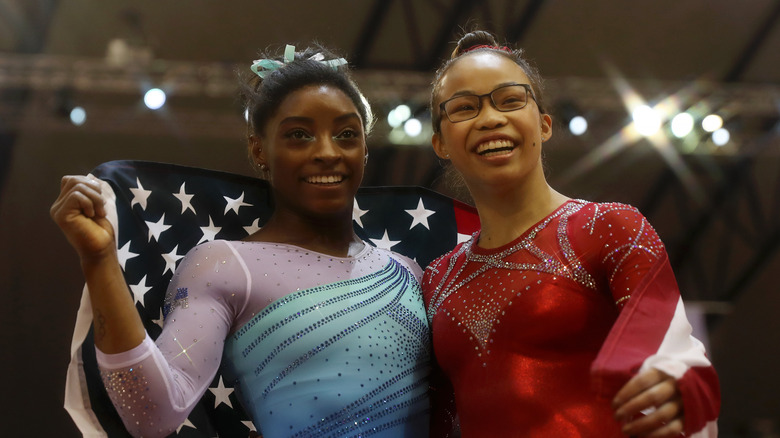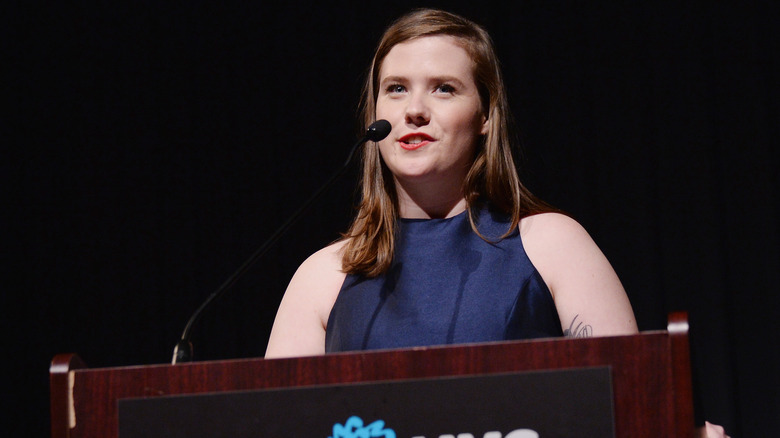The Untold Truth Of Abuse Within USA Gymnastics
The USA Gymnastics sexual abuse scandal, as it came to be known colloquially, is the biggest, most shocking impropriety to rock one of the most beloved and well-respected sports institutions in the world. And let's hope it stays that way.
USA Gymnastics is the sport's national governing body. It develops the U.S. Olympic team and promotes gymnastics, as well as the surrounding industry, across the board. With disturbing allegations spanning over 10 years, a culprit who outwardly couldn't have appeared nicer or more congenial, and victims numbering in the hundreds, the revelations were a shock to the system. They had a seismic impact both on the sport itself and the people employed within it.
Media struggled to report the increasingly garish details, victims stood for their day in court one by one by one, and Congress was finally forced to take action. This is the horrifying untold truth of abuse within USA Gymnastics.
USAG is no stranger to scandals
The 2016 scandal isn't the first time USAG has found itself at the center of controversy. In fact, there have been numerous incidents over the years, leading the organization to create a list of permanently banned coaches all the way back in 1990. As detailed in their entirety by the The Washington Post in a piece brilliantly headlined "A legacy of inaction," these issues were prevalent since the late 80s. In 1987, a woman even claimed she was raped at a Junior Olympics camp, but the authorities were never advised.
The Indianapolis Star detailed how this was a running theme for USAG, which protected coaches by neglecting to inform law enforcement, clearly showcasing a pattern of abuse within the organization. USAG also frequently dismissed allegations as hearsay unless they came directly from the victim or their guardian. One such mother, whose daughter filed a lawsuit against the organization, claimed, "USA Gymnastics had enough information... to have done something about this. It didn't have to happen to my daughter, and it didn't have to happen to other little girls."
Who is Larry Nassar?
Even within a culture of silence, where then-president Steve Penny himself noted, "There's no duty to report if you are... a third-party to some allegation. You know, that lies with the person who has firsthand knowledge," (as per the Indianapolis Star), Larry Nassar was an anomaly. Time did a deep-dive on him, noting the licensed osteopath was beloved across USAG, which he worked with as a volunteer physician for 30 years.
Dr. Nassar, a married father of three (his wife filed for divorce in January 2017), also worked at Michigan State University's school of osteopathic medicine. He became a fixture at USAG after being personally invited to the legendary Karolyi ranch in Texas, where minor girls were often coached without parental supervision. A report in the Indianapolis Star details how Nassar's treatment of gymnast Kerri Strug, who performed with an injured ankle, supposedly helped her secure the gold medal in the 1996 Olympic Games. Penny himself previously praised Nassar as being, "Instrumental to the success of USA Gymnastics."
It all started with Rachael Denhollander
In September 2016, the first woman to publicly accuse Nassar came forward. The Indianapolis Star published gymnast Rachael Denhollander's harrowing account after she filed a police complaint against him at MSU, where she had been treated as a teenager. Denhollander was just 15 at the time, and received five treatments total, which were not, in fact, treatments at all, but rather sexual abuse at the hands of Nassar — all while her mother was present.
Nassar's abuse often occurred while parents or guardians were there, with doctor and patient positioned in such a way they couldn't see what was really going on. Denhollander recalled being "terrified," "ashamed," and "very embarrassed" as she laid on the table, "Trying to reconcile what was happening with the person he was supposed to be." During Nassar's preliminary hearing, Denhollander told the court (via CNN), "I want him and I want the public to know that I know where the shame and the guilt for this lies. It lies on him and not on me, and I am not afraid of the truth."
Opening the floodgates
The original Indianapolis Star exposé included another, anonymous accuser whose reports of abuse echoed Denhollander's, hinting at an emerging pattern that, unbeknownst to Nassar's accusers, stretched out over 14 years and involved hundreds of girls. At the last of his sentencing hearings in Michigan, the judge noted, "We have over 265 identified victims and an infinite number of victims in the state, in the country, and all over the world," (as reported by the BBC).
Around 140 of those victims sued Nassar and USAG for ignoring the allegations, demanding monetary reparations for pain and suffering caused by the physician and his so-called "treatments." The first victim to speak in court, Jessica Thomashow (17), advised, "He first molested me when I was 9... before I had braces, and when I still played with my American Girl dolls. Larry Nassar preyed on us for his own pleasure, leaving in his wake traumatized and broken girls."
60 Minutes with three Olympic athletes
The noose tightened around Nassar's neck when not one but three Olympic gymnasts stepped forward to tell their stories. Appearing on 60 Minutes, Jeanette Antolin, Jessica Howard, and Jamie Dantzscher detailed how they were abused at Karolyi Ranch, the same place where Nassar's USAG career first took off. The women described Nassar's positive, upbeat attitude as a welcome reprieve from the stresses of training, explaining how they saw him as a friend and ally.
Antolin, a member of the U.S. National Team from 1995-2000, recalled, "He was someone that we would talk to when we were getting treatment, if we had a hard day. ...When it's such a serious environment that would be the world. It could fix your day." As a result, the women didn't question his methods, even when they seemed unorthodox. Howard, the U.S. National Champion in rhythmic gymnastics from 1999 to 2001, argued they couldn't complain regardless, explaining, "That's one of the first rules of being an athlete. You need to be strong, silent, and let everything go."
Maroney says #MeToo
Two-time Olympic medalist McKayla Maroney took to Twitter to reveal that she, too, had been abused by Nassar. As per ESPN, in a since-deleted Tweet, Maroney invoked "#MeToo." The athlete, who helped her team, the Fierce Five, win gold at the 2012 Summer Games in London, detailed how Nassar started abusing her when she was just 13, again at the Karolyi camp.
"It seemed whenever and wherever this man could find the chance, I was 'treated,'" she wrote. Maroney also detailed a frightening incident on a trip to Tokyo. "He'd given me a sleeping pill for the flight, and the next thing I know, I was all alone with him in his hotel room getting a 'treatment.' I thought I was going to die," she admitted.
It was subsequently revealed, in another report by ESPN, that Maroney was coerced into signing a non-disclosure agreement for somewhere in the region of $1 million to keep the abuse under wraps (she later sued). Maroney's mother admitted, in a letter to USAG, that she worried her daughter would kill herself after the trauma she'd been through.
Raisman raises her hand
Aly Raisman, another member of the Fierce Five, also spoke to 60 Minutes about the abuse she suffered at Nassar's hands. Raisman, who won six medals, three of them gold, further detailed the heartbreaking story in her book Fierce, which details how her Olympic dreams were shattered by the disgraced doctor.
On 60 Minutes, the gold medalist revealed she'd even spoken to the FBI about Nassar after the Rio Olympics. When questioned about why the abuse didn't come to light sooner, Raisman argued the toxic culture of USAG is to blame. "What did USA Gymnastics do, and Larry Nassar do, to manipulate these girls so much that they are so afraid to speak up?" she railed.
The gold medalist felt especially bad for all the young women coming up under her, noting, "I just want to create change so that they never, ever have to go through this."
Douglas lashes out, but she's a victim too
Maroney and Raisman's Fierce Five teammate, Gabby Douglas was criticized for replying to Raisman's message about the scandal and advising women should dress more modestly to avoid landing themselves in potentially dangerous situations. After a huge amount of backlash, Douglas apologized, as reported by The Guardian, confirming she stood with her peers.
It was later revealed that Douglas was also one of Nassar's many victims. As reported by The New York Times, the Olympian took to social media to admit she was wrong to misspeak as, "It would be like saying that because of the leotards we wore, it was our fault that we were abused by Larry Nassar." Douglas explained: "[I] didn't publicly share my experiences as well as many other things because for years we were conditioned to stay silent and honestly some things were very painful." Her publicist confirmed to the Times that the Olympic athlete was, indeed, a victim too.
The names just keep on coming
With a rumored 265 victims total, there were more women coming forward than reporters could keep up with. Gymnast Maggie Nichols revealed she was the very first to alert USAG about Nassar back in 2015. The athlete explained to ESPN, "His job was to care for our health and treat our injuries. Instead, he violated our innocence."
The pattern of abuse was clearer still in the story of Alyssa Baumann, who was abused at age 15, again at the Ranch. Baumann, like Maroney and Douglas, took to Twitter to say #MeToo, acknowledging Nassar had abused her for years. Speaking to Dallas News, Baumann echoed others' recollections of how nice and well-respected Nassar was, advising, "I knew that [the treatment] made me extremely uncomfortable. But I thought it was for all the right reasons. Everybody told me he was the best."
Also speaking to Dallas News, gymnast Kennedy Baker, a former national team member, revealed the abuse was so prevalent it even occurred at the 2012 Olympic trials. Baker blames a fall off the balance beam on nerves, because she'd received "treatment" just a half hour previous.
USAG didn't want to know
A major through-line in all of these stories is the fact USA Gymnastics didn't want to hear about the allegations against Nassar. If the accusations didn't come directly from the abused (such as from a friend or coach she may have confided in), they weren't even entertained. This was a constant with Penny, as noted in gymnast Maggie Nichols' court filings and interviews.
As reported by Sports Illustrated, she and her mother Gina were discouraged from coming forward about Nassar. "[When] I have Steve Penny telling me this is what we're going to do, we're going to be quiet, I'm going to listen to him. I'm not going to jeopardize my daughter's chance of going to the Olympics," Gina Nichols explained.
This was echoed, once again, by Olympian Tasha Schwikert, who came forward in late 2018 to accuse Penny of pressuring her to keep quiet about Nassar too (via NBC Sports). Schwikert wrote on Twitter that it was, "Time for @USAGym and @TeamUSA to come clean and be held accountable for the toxic environment that enabled Nassar's abuse. Only then will we see REAL change."
Facing the music 156 times over
When the time came for Nassar to face trial, he also had to face a whole slew of his victims. The BBC reported on the 156 brave women who confronted their accuser in court, many of whom waived their right to anonymity. Kyle Stephens, the first to speak, told the publication, "It was really empowering to get up there and give my story from start to finish." After requesting to address Nassar directly, Stephens told him, "Perhaps you have figured it out by now, but little girls don't stay little forever. They grow into strong women who return to destroy your world."
Judge Rosemarie Aquilina described the disgraced doctor as "delusional" for claiming it was too difficult to sit there and listen to his victims, as per The Huffington Post. "Spending four or five days listening to them is significantly minor considering the hours of pleasure you had at their expense and ruining their lives," Aquilina stated.
"I just signed your death warrant"
Judge Aquilina wasn't messing around when it came to Nassar's final, life-ending sentence either. As reported by the New York Times, Aquilina revealed to the court (which, to be clear, was filled with Nassar's victims) that his professed contrition was farcical based on the letter he'd submitted just the week before, complaining about his own supposedly harsh treatment.
"This letter tells me you have not yet owned what you did. You still think somehow you are right, you're a doctor, that you're entitled, so you don't have to listen. That you did 'treatment.' I wouldn't send my dogs to you, sir," Aquilina spat at him.
Then, when giving her final verdict, the judge delivered another killer blow, telling Nassar, "I just signed your death warrant." The disgraced doctor was previously sentenced to 60 years in prison for child pornography charges. Judge Aquilina sentenced him to a further minimum 40 years, maximum 175 in case he outlives us all.
A predator unlike any other
The final person to speak at Nassar's hearing was also, coincidentally, the first victim to come forward with her story. Rachael Denhollander, described by Judge Aquilina as "The bravest person I have ever had in my courtroom," explained Nassar is, "The most dangerous type of abuser. One who is capable of manipulating his victims through coldly calculated grooming methodologies, presenting the most wholesome and caring external persona as a deliberate means to ensure a steady stream of young children to assault," (via The New York Times).
In a shocking deep dive, The Cut delved into how Nassar managed to convince so many people for so long that he was the nicest guy in the world. Nassar depended on coaches, parents, and institutions backing him up against scared and hurt victims, which they did for many, many years. His reach was such that, even nowadays, certain parents remain grateful to him, with one even admitting, "I really believe Larry at some point in his life thought it was the appropriate treatment. I don't know when he went to the dark side and changed it."
Changing the law
The USAG scandal led to Senator Dianne Feinstein introducing a bill that would require national governing body members overseeing Olympic sports to immediately report sexual assault allegations to law enforcement or designated child-welfare agencies. Failure to report such crimes would be classed as a federal crime. The New York Times reported that the organization was invited to testify at the congressional hearing, but refused. Much like at Nassar's trials, however, several of the affected gymnasts took the opportunity to share their stories once again.
Rick Adams, chief of Paralympic sports for the United States Olympic Committee, apologized for the mishandling of the situation, saying, "The Olympic community failed the people it was supposed to protect. We do take responsibility, and we apologize to any young athlete who has ever faced abuse." When asked whether she believed USAG knew about the ongoing abuse, Feinstein told reporters, "Absolutely, yes, I do." Her bill became law in early 2018.
Tumbling towards progress
USAG tried to move forward in the wake of the Nassar scandal, but not without stumbling. Penny stepped down in 2017, as per The New York Times, under intense pressure from all sides. Edward Nyman, a former gymnast and the organization's new full-time director of sports medicine and science, was fired for unspecified reasons after just one day, as reported by The Washington Post. The announcement of his initial hiring didn't go down too well either, with four-time gymnastics world champion Simone Biles tweeting, "I'm sorry... what" in response.
USAG filed for bankruptcy in December 2018, and new president and CEO Li Li Leung (their fourth in two years), rubbed everyone the wrong way when she claimed Nassar hadn't abused her because Leung's coach never left her side — clearly, this was never a deterrent for the disgraced doctor and Leung simply got lucky. Speaking to the Indianapolis Star, Leung remained optimistic, explaining she took the job as, "I felt that I could make a positive impact. ...It was an opportunity to be able to shape a sport that has shaped me, and a sport that I love."
An upsetting, infuriating doc reveals all
A tell-all documentary entitled At The Heart of Gold: Inside the USA Gymnastics Scandal, from filmmaker Erin Lee Carr, shed further unflattering light on the USAG abuse scandal. The film debuted at Tribeca 2019, with Variety calling it an "upsetting and infuriating doc" that "exposes the far-reaching consequences of such monstrousness, which, no matter the courageous and inspiring resilience of its many survivors, has clearly left profound, lasting scars." Likewise, The Hollywood Reporter noted the film is strongest when, "It focuses victims' grievances at the systemic inequities that allowed a Nassar to happen and endure, in the process revealing how difficult it is... to hold people accountable and to enact real change."
The documentary, which premiered on HBO in May 2019, was a labor of love for Carr. She explained to Vulture, "I remember getting back from [the sentencing hearing in] Michigan and I felt changed as a person. And then I think about the survivors and I think, 'How do they do anything?' They're these remarkable women who are having lives and having babies and having jobs and being advocates. Like, you are the truest hero I have ever met."
